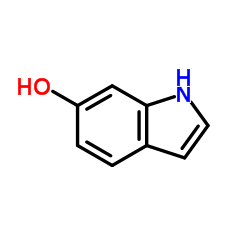Enterohemorrhagic Escherichia coli biofilms are inhibited by 7-hydroxyindole and stimulated by isatin.
Jintae Lee, Tarun Bansal, Arul Jayaraman, William E Bentley, Thomas K Wood
Index: Appl. Environ. Microbiol. 73(13) , 4100-9, (2007)
Full Text: HTML
Abstract
Since indole is present at up to 500 microM in the stationary phase and is an interspecies biofilm signal (J. Lee, A. Jayaraman, and T. K. Wood, BMC Microbiol. 7:42, 2007), we investigated hydroxyindoles as biofilm signals and found them also to be nontoxic interspecies biofilm signals for enterohemorrhagic Escherichia coli O157:H7 (EHEC), E. coli K-12, and Pseudomonas aeruginosa. The genetic basis of EHEC biofilm formation was also explored, and notably, virulence genes in biofilm cells were repressed compared to those in planktonic cells. In Luria-Bertani medium (LB) on polystyrene with quiescent conditions, 7-hydroxyindole decreased EHEC biofilm formation 27-fold and decreased K-12 biofilm formation 8-fold without affecting the growth of planktonic cells. 5-Hydroxyindole also decreased biofilm formation 11-fold for EHEC and 6-fold for K-12. In contrast, isatin (indole-2,3-dione) increased biofilm formation fourfold for EHEC, while it had no effect for K-12. When continuous-flow chambers were used, confocal microscopy revealed that EHEC biofilm formation was reduced 6-fold by indole and 10-fold by 7-hydroxyindole in LB. Whole-transcriptome analysis revealed that isatin represses indole synthesis by repressing tnaABC 7- to 37-fold in EHEC, and extracellular indole levels were found to be 20-fold lower. Furthermore, isatin repressed the AI-2 transporters lsrABCDFGKR, while significantly inducing the flagellar genes flgABCDEFGHIJK and fliAEFGILMNOPQ (which led to a 50% increase in motility). 7-Hydroxyindole induces the biofilm inhibitor/stress regulator ycfR and represses cysADIJPU/fliC (which led to a 50% reduction in motility) and purBCDEFHKLMNRT. Isogenic mutants showed that 7-hydroxyindole inhibits E. coli biofilm through cysteine metabolism. 7-Hydroxyindole (500 microM) also stimulates P. aeruginosa PAO1 biofilm formation twofold; therefore, hydroxyindoles are interspecies bacterial signals, and 7-hydroxyindole is a potent EHEC biofilm inhibitor.
Related Compounds
| Structure | Name/CAS No. | Molecular Formula | Articles |
|---|---|---|---|
 |
6-Hydroxyindole
CAS:2380-86-1 |
C8H7NO |
|
Determination of selected synthetic cannabinoids and their m...
2016-04-01 [Talanta 150 , 568-76, (2016)] |
|
Inhibitory effect of hydroxyindoles and their analogues on h...
2010-01-01 [Z. Naturforsch., C, J. Biosci. 65 , 49-54, (2010)] |
|
Albumin stimulates the activity of the human UDP-glucuronosy...
2013-01-01 [PLoS ONE 8(1) , e54767, (2013)] |